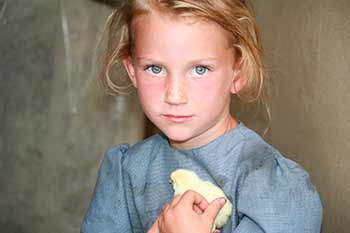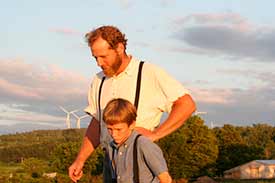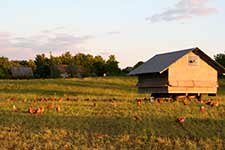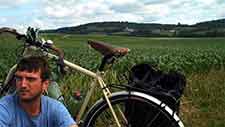CAZENOVIA, NEW YORK
“Have you ever ridden in a car that runs on vegetable oil?”
“No. I have not,” I replied.
Eric Woodworth, the owner of Circa Restaurant in Cazenovia, New York, walked into the kitchen, grabbed a large pot of hot vegetable oil, walked out through the back door, and poured the oil into the gas tank of his 1984 Mercedes Benz.
Before I jumped into Eric’s front seat I asked, “Why do you do this?”
“Do what?” he said.
“Why do you want to run your car on vegetable oil?”
Eric looked at me as though I had just asked him an annoying rhetorical question and with a condescending tone he said, “We are at war over foreign oil right now and I think we should at least experiment with other ways to be more self-sufficient and growing corn is not the solution.”
Eric was my tour guide of his native New York countryside. By chance, I had met his wife Alicyn and the chef at Circa Restaurant on the street just 5 minutes after I had arrived in town. Alicyn invited me to check out their locally sourced menu and talk to her and Eric about the local farming community. As Eric and I enjoyed a beer, I mentioned I was interested in meeting one of the farmers who provides Eric’s restaurant with fresh grass-fed meat. He informed me that he had the perfect farmer in mind.
As Eric and I drove up and over the soft and green rolling hills of rural central New York, just 20 miles south of Syracuse, I marveled at the dilapidated barns and broken-down tractors decaying on farmers’ fields. Eric’s lofty but casual comments painted a careful picture of his hometown and the economic woes farmers are facing in the region. “This guy over here is conventional, most are around here,” and, “This guy over here just inherited his parents’ farm. You can’t buy a farm and make any money in this part of the state. It’s got to be inherited, otherwise it’s just impossible.”
Suddenly, we made a sharp right turn onto a short, rocky driveway leading to a farm. I noticed two young children wearing dark and simple clothing, jumping on a trampoline and a woman wearing a long dress and bonnet hard at work, weeding and harvesting vegetables in the garden. Eric slowly parked the car in front of the Amish farmhouse and I snapped a few photographs of the children as they continued to play in this idyllic place.
Leisurely walking towards our car to greet us was a man with a light-colored beard and wearing a white shirt with thin suspenders. “This guy is really cool and practices some sweet farming methods. A lot of women around here think this guy is really hot,” Eric noted.
Juxtaposed with the conservative work-ready attire of our hosts, I felt like an idiot with my Birkenstocks, cargo shorts, and chunky SLR camera dangling free and ornate around my neck. I wanted to make a strong first impression so I added a little elbow grease and direct eye contact to my hand-to-hand greeting. He introduced himself as Daniel Kline. Right away I understood why the ladies of rural New York took a shine to him. His eyes were a brilliant shade of blue; his skin was tanned and his brown hair was lightened to a golden blonde from his time spent working outdoors. He had rolled up his shirtsleeves to his elbows, revealing strong forearms. His black suspenders complemented his fit waistline and dark work pants.
I began to ramble about why I was here: my quest for knowledge surrounding sustainability, the American food system, and other facets of modern life that the Amish have very little need to worry about, given their creed of self-sufficiency.
In an effort to gain credibility with Daniel, I mentioned that I was from Lancaster County, Pennsylvania. With his strong Pennsylvania Dutch dialect Daniel said “Oh! You are from Lancaster, are ya, huh? I have been there a few times. It is a nice place.” Secretly, I wanted to tell Daniel that I felt Lancaster County and its urban sprawl is going to hell in a handbasket. I decided to just let it go. But a moment later Daniel confirmed my feelings on the county by stating, “Lancaster sure is filling up fast. You can’t buy a farm for less than one or two million dollars down there and we can’t farm for that. So we moved up here.” His words were gentle, yet brutally clear, and they left me with little more to say than a soft, saddened, “I know exactly what you mean.”
When we arrived on Daniel’s farm, he had been shoveling chicken grain into a large storage bin. Both Eric and I expressed our wish to let Daniel continue his work, yet Daniel insisted on giving me a tour of his farm. “If we have a visitor on the farm I usually take time off. That is what farming is all about.”
Daniel’s words were nothing short of honest and carefree. I began to notice a pattern in his nonchalant behavior. Looking around the farm, there was a sense of ease and simplicity. There seemed to be no pressure or competition creating unwanted work without peace of mind. Everything felt so simple, permissible, and charming. There was no stress over the struggling economy, no worries about the rising cost of oil. Daniel and his family were living what appeared to be an ideal life of earthly contentment and satisfaction.
“This is some beautiful land you have here. How many acres do you own?” I asked Daniel as we took a slow walkabout.
“We have about ninety-seven acres to the farm,” he replied. Pointing at a large tilled plot he said, “This is our big garden. Sometimes the children disappear for long periods at a time. When they return we always know where they have been because the fresh strawberries leave red stains on their faces.” We shared a laugh and I crouched down to pick one of Daniel’s strawberries. As its flavors danced across my taste buds I understood why Daniel’s children disappeared into the garden.
“Over there is our milk cow. She is dry right now, but she gives us our milk, butter, and cream,” Daniel said proudly. Daniel then pointed out a handful of steers he raises for grass-fed beef-how Daniel and Eric came to know each other through Circa Restaurant in the first place. Each day these cows are led to fresh paddocks of lush grass as part of a rotational grazing system. In essence this method imitates the natural grazing habits of bison across the Great Plains and was used until the 1950s when large corporations began to industrialize the production of meat through grain, pens and feedlots.
Very recently, the grass-fed feeding strategy has been resurrected and made popular by charismatic celebrity farmer and author of Salad Bar Beef, Joel Salatin, who reminds us whenever he can of the environmental impacts and safety risks that come with the production of industrial meat. With the increasing popularity of both farmers’ markets and the local food movement, small grass-fed beef producers are finding more avenues for consumers who are looking for an alternative to “factory farmed” meat to find their products.
As I sat and watched Daniel’s cows graze on their fresh pasture, Eric walked over to stand next to me. “The whole town is pissed off because we charge ten bucks for a grass-fed hamburger, which reduces the amount of resources it takes to produce a meal and creates less impact on our planet. Meanwhile they all pay three dollars for a gallon of gas and drive around in oversized trucks.” He shrugged his shoulders, shook his head, and walked away.
Without the hum of diesel engines or heavy machinery on Daniel’s farm, the world seemed dead silent. When I listened closely, I could hear the tongues of grazing cows tearing off fresh blades of grass.
Daniel and I walked leisurely to a distant pasture to get a closer look at Daniel’s chicken tractor. This impressive hen house was built on the base of an old wagon with four wheels and a hitch up front. I envisioned Daniel’s draft horses moving the chicken “motel” to fresh pasture daily. The chickens’ forage had been grazed by Daniel’s beef cows just a few days earlier. Essentially, this was a working model of young organic farmer Garin Smith and his symbiotic roadmap to sustainability I had encountered back in Skowhegan, Maine on Grassland Organic Farm.
Inside the henhouse, feeders and water buckets dangled from the ceiling and nesting boxes were built intuitively around the outside of the entire structure, allowing anyone to collect the eggs without actually going inside the building. Daniel reached down, grabbed an egg from a nesting box, and cracked it open onto his hand. Pointing out the rich yolk he said, “Our chickens feast on clover which is high in protein. That is what gives the yolk that dark orange color.”
As my farm tour continued I expressed an interest in seeing the pigs that Daniel had mentioned earlier. Growing up, my late father’s best friend was somewhat of a conventional pig farmer. I say “somewhat” because he didn’t actually own the pigs and many (including corporate farmers) considered him just another hired hand. Essentially, in exchange for doing the feeding chores he was given a private mobile trailer so he and his family could live peacefully in the Lancaster County countryside. These pigs were raised in confinement and in all the years my dad and I visited (to enjoy fishing and a few cold beers) I never did get to see any of those hogs.
That day, like most days, Daniel’s pigs rooted through the rich soil with their strong noses, slept, and built wallows. All summer they feast on brush, plants, berries, and apples that fall into their pens from the trees and brush around them. As if this gourmand diet isn’t impressive enough, Daniel has a connection in New York City, the owner of a small market with a plethora of gourmet cheeses that often don’t get sold before their sell by date. He brings the spoiled cheese to Daniel and his pigs. This arrangement saves the store owner the cost of disposing the spoiled goods and provides Daniel’s pigs with a luxurious snack, which fattens them up well before they make it to market. As the mob of pigs grazed the overgrowth and fertilized the soil, I laughed, seeing that these pigs were some of the most productive workers on the farm. And in this respect they were just like Daniel Kline himself, happy to do the work, whether or not anyone was watching.
When my tour of Daniel’s slice of heaven was complete he walked me to his barn where he had converted one section into a small guest room. He lit a gas lamp and kindly offered me an overnight stay. As my mind swirled, I watched Daniel’s young daughter run barefoot through the pasture as the early evening sun cast hard light over her long blonde hair. My heart told me to politely decline Daniel’s offer and get back in Eric’s Mercedes. Daniel’s living arrangement with Mother Nature felt so distant from the life that I had somehow created–filled with the conformity, greed, and confusion that comes with a “conventional” world.
And, for me, there are times when witnessing the happiness of another person can be just as painful as dealing with my own sadness. Daniel Kline had more than just a sustainable farm. He had a genuine life and a satisfied mind about his relationship to the land and the universe. I had neither of the two.
And so I left.
Read the Unconventional Harvest series:
- On the Road to Find the Future of Food and Farming
- Grassland Organic Farm
- Wellspring Farm
- My Visit to an Amish Farm in New York
- Farm Sanctuary
- An Urban Oasis for Food
- Tantré Farm
- Conventional Dairy Farmer Art Thelen
- New Forest Farm
- A Large No-Till Organic Farm
- Melstone, Montana—Population 136
- In the Farmers Own Words
Nathan Winters rode a bicycle across America to discover first-hand why our food system had grown to be unsustainable, and to find alternative solutions. He traveled into the homes and communities of organic, conventional, urban and Amish farmers and community organizers. This ongoing series—to be posted every other Wednesday— represents select material from The Unconventional Harvest, a work in progress, by Nathan A. Winters.






